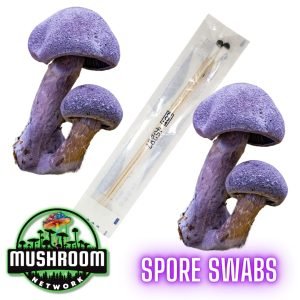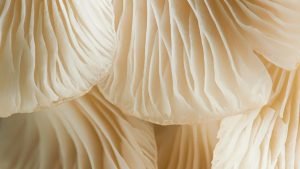The mystical world of mushrooms harbors a plethora of species with unique properties, and Ganoderma Sinense, often known as the “Phantom Mushroom,” or Reishi is a standout specimen. Valued for its therapeutic potential, this unique mushroom holds an esteemed place in traditional medicine and may well be a potent source of modern-day treatments.
Delving Deeper: Ganoderma Sinense is a member of the Ganodermataceae family and forms a part of the broader grouping of Reishi or Lingzhi mushrooms. This perennial fungus displays a characteristic fan-shaped, glossy cap and thrives in the deciduous forests of East Asia, living symbiotically with trees. Its shiny exterior, coupled with its therapeutic history, imparts a sense of enigma, earning it the intriguing nickname, the “Phantom Mushroom“.

TRACING THE ROOTS OF GANODERMA SINENSE:
Known as ‘Lingzhi‘ in China, Ganoderma Sinense has a deep-seated presence in the region’s traditional medicinal system. For over 2000 years, this mushroom has been heralded as a panacea, a treatment for all ills, and has been associated with health, longevity, and spiritual potency.
Ancient Chinese texts document its use in treating ailments ranging from fatigue and cough to arthritis and liver disease. Such was the high regard for Ganoderma Sinense that its depiction became a common motif in art, representing good health and long life.
The high esteem and widespread use of Ganoderma Sinense in traditional medicine have sparked curiosity in the scientific community, leading to several studies on its medicinal potential.

THE SCIENCE BEHIND THE PHANTOM MUSHROOM:
Studies reveal that the therapeutic potential of Ganoderma Sinense lies in its bioactive compounds. The mushroom contains an array of polysaccharides and triterpenoids, which have shown a range of therapeutic effects, from anti-inflammatory and antioxidant to anti-tumor activities.
Research suggests that the polysaccharides in Ganoderma Sinense may boost the immune system, aiding the body in warding off diseases. Additionally, these polysaccharides may also exhibit anti-cancer properties by inhibiting tumor growth and triggering apoptosis, the process of programmed cell death.
The triterpenoids, on the other hand, are responsible for the mushroom’s anti-inflammatory and antioxidant effects. They may help mitigate oxidative stress, a contributing factor to chronic conditions like cardiovascular disease and cancer.
The universe of mushrooms is expansive, each variant bearing its own unique charm and characteristics. The Marketplace on the 🍄 Mushroom Network is a testament to this diversity. It is a haven for those seeking a deeper understanding of the magical world of mushrooms. If you’re keen on learning more about this type of mushroom and other mushroom variants, this Marketplace is your ultimate resource.
POTENTIAL MEDICINAL USES AND FUTURE RESEARCH:
The bioactive compounds of Ganoderma Sinense have shown promising results in preclinical studies. Their potential applications are vast – ranging from cancer therapy and immune system modulation to treatments for neurodegenerative diseases and aging.
The mushroom’s immune-boosting properties could be harnessed in developing treatments for conditions resulting from a weakened immune system. Additionally, its anti-inflammatory and antioxidant properties might make it a potential natural remedy for chronic inflammatory diseases.
Despite the promising initial results, it’s crucial to underscore that more extensive clinical trials are required to substantiate these effects and understand the underlying mechanisms. Furthermore, efforts need to be made to improve the cultivation techniques and yield of Ganoderma Sinense to meet potential future demands.
Not sure where to start? The 🍄 Mushroom Academy offers a wide range of courses tailored to your needs. Whether you’re a beginner eager to learn or an experienced mycologist looking to broaden your knowledge, the 🍄 Academy has something for everyone.

Towards a Healthful Horizon:
The fascinating journey of Ganoderma Sinense from the ancient forests of East Asia to the cutting edge of medicinal research underscores the untapped potential of mycology. As science unravels the secrets of the “Phantom Mushroom,” we edge closer to turning traditional wisdom into novel treatments.
Don’t forget to check out the 🍄 Mushroom Network’s Marketplace to see what’s available. But hurry, our shelves are constantly evolving, and you wouldn’t want to miss out on this wonderful mushroom. Join our growing network of Patrons, Genetics, and Mycologist Vendors only on the 🍄 Mushroom Network!
Recommended Reads:
Substrate for Mycology: A Comprehensive Guide on Using Manure
From the ancient pastures to the modern mycologist’s toolkit, manure has long been a foundation...
Read More...The Health Benefits of White Oyster Mushrooms
White Oyster Mushrooms (Pleurotus Ostreatus) are prized globally not just for their culinary versatility but...
Read More...RECIPE: Warm Quinoa, Spinach, and Shiitake Salad
Introduction: Embrace the essence of wholesome eating with this Warm Quinoa, Spinach, and Shiitake Salad....
Read More...Galactic Fungi: The Mycelium Awakens with Jedi Mind F**k (JMF)
About This Article: Is Jedi Mind F**k the Obi-Wan of mushrooms or just a fungal...
Read More...Whoa there, Spore Sport! 🍄 Looks like you’re not logged in yet. Don’t you know what you’re missing? MYCO-CREDITS! Imagine all the fungal fun you could have. It’s like finding a Morel in May and not picking it. Tragic, right? Log In or Become a Myco-Patron and start racking up those credits. It’s more rewarding than finding a mushroom in your backyard! 🌟🏡













